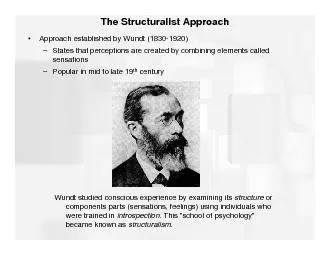/


Wundt studied conscious experience by examining its structure or components parts sensations feelings using individuals who were trained in introspection This school of psychology became known a ID: 182605
Download Pdf The PPT/PDF document "The Structuralist Approach" is the property of its rightful owner. Permission is granted to download and print the materials on this web site for personal, non-commercial use only, and to display it on your personal computer provided you do not modify the materials and that you retain all copyright notices contained in the materials. By downloading content from our website, you accept the terms of this agreement.
The Structuralist ApproachApproach established by Wundt (1830-1920)States that perceptions are created by combining elements calledsensationsPopular in mid to late 19thcentury Wundt studied conscious experience by examining its structure or components parts (sensations, feelings) using individuals who were trained in introspection. This "school of psychology" became known as structuralism Structuralism could not explain apparent motion Structuralism could not explain apparent motion Structuralism could not explain illusory contourseither. It seems that the visual system looksfor regularity and patterns.We often seeor infer structure when its not actually there. The Gestalt ApproachAccording to Gestalt psychologists, the whole is different than the sum of its parts. Gestalt is a German word meaning configuration or pattern.Perception is notbuilt up from sensations but is a result of perceptual organizationGestalt principles do not make strong enough predictions to qualify as lawsThey are better thought of as heuristics-best guess rulesThe following lawsdescribe heuristics for how elements in a scene tend to group together. The Gestalt laws of perceptual organizationPragnanz:Every stimulus pattern is seen in such a way that the resulting structure is as simple as possible. The Gestalt laws of perceptual organizationSimilarity:Similar things appear to be grouped together. The Gestalt laws of perceptual organizationSimilarity:Similar things appear to be grouped together. The Gestalt laws of perceptual organizationGood continuation:Points that, when connected, result in contours. These contours follow the smoothest path. The Gestalt laws of perceptual organization Good continuation:Points that, when connected, result in contours. These contours follow the smoothest path. The Gestalt laws of perceptual organizationGood continuation:Points that, when connected, result in contours, and these contours follow the smoothest path. Neurons in V1 seem to support good continuation1 2 3 4 5 6 7 8Improvement in visual sensitivity by changes in local context: Parallel studies in human observers and in V1 of alert monkeys Kapadia,Ito,Gilbert,and WestheimerNeuron,1995 The Gestalt laws of perceptual organizationProximity(nearness) things that are near to each other are grouped together The Gestalt laws of perceptual organizationProximity vs. SimilarityWhich one wins? The Gestalt laws of perceptual organizationIt depends The Gestalt laws of perceptual organizationCommon Fatethings that move together belong together The Gestalt laws of perceptual organizationCommon region-elements in the same region tend to be grouped together The Gestalt laws of perceptual organizationUniform connectednessa connected region of visual properties is perceived as single unit The Gestalt laws of perceptual organizationSynchrony -elements occurring at the same time are seen as belonging together. The Gestalt laws of perceptual organizationMeaningfulness or Familiarity-Things are more likely to form groups if the groups appear meaningful or similar. Bev Doolittle (1985) Pareidolia(payr.eye.DOH.lee.uh) . The erroneous or fanciful perception of a pattern or meaning in something that is actually ambiguous or random. On Mars On the Moon On (Google) Earth In smoke and fire and snow In smoke and fire and snowOctober 16, 2007: Is this Pope John Paul II waving from beyond the grave? Vatican TV director says yesThis fiery figure is being hailed as Pope John Paul II making anappearance beyond the grave.The image, said by believers to show the Holy Father with his right hand raised in blessing, was spotted during a ceremony in Poland to mark the second anniversary of his death. In rocks In trees On food. Do cars have faces? Figure-Ground SegregationDetermining what part of environment is the figure so that it stands outfrom the background Figure-Ground SegmentationFigure is usually:In the lower part of the displaySymmetricConvexRelatively small in areaOriented vertically rather than obliquely Figure-Ground SegregationElements located in the lower part of displays tend to be seen as figure. Area Smaller areas tend to be perceived as figure. Vertical and horizontal components tend to be perceived as figure.Area and orientation compete here Orientation Smaller areas (the black shapes) tend to be perceived as figure.